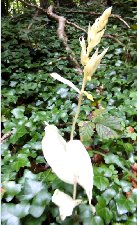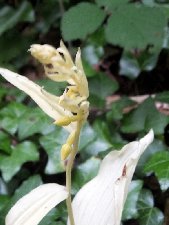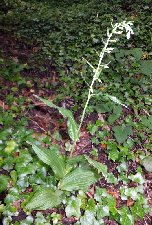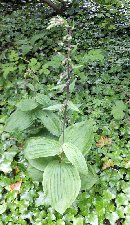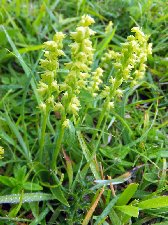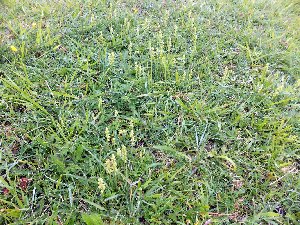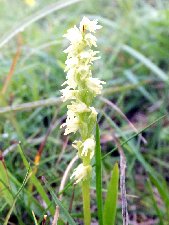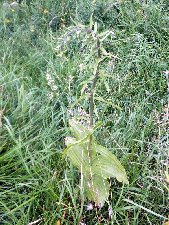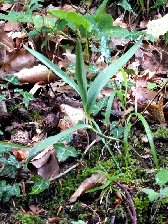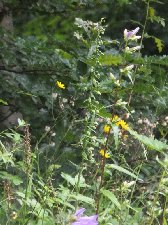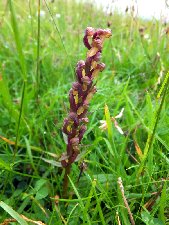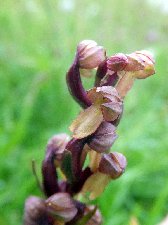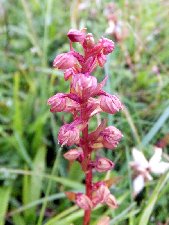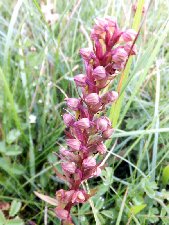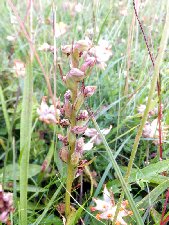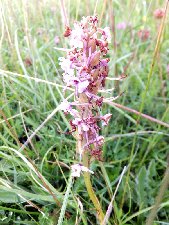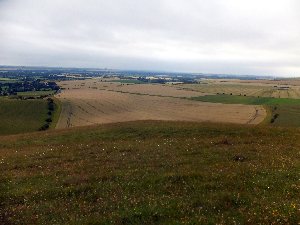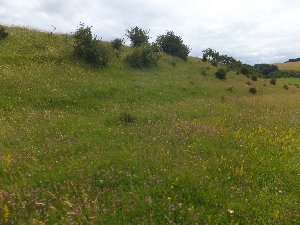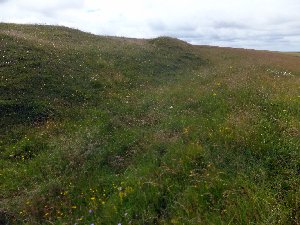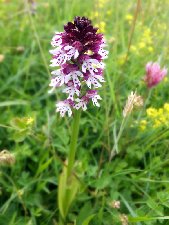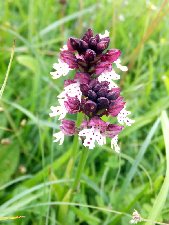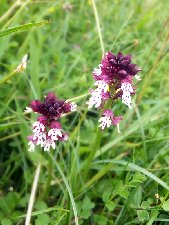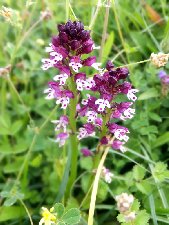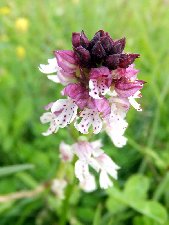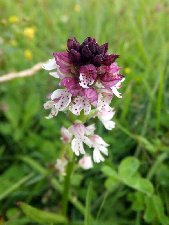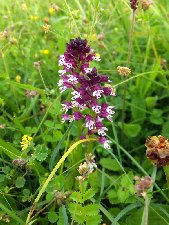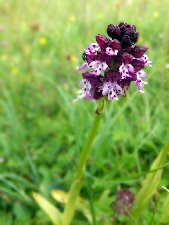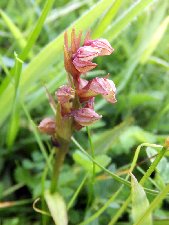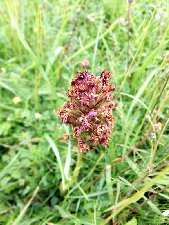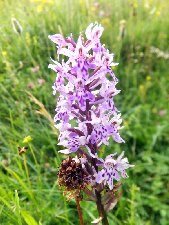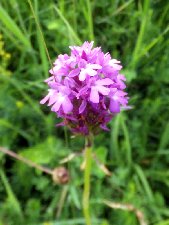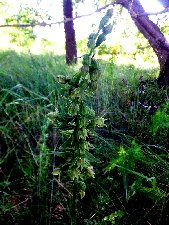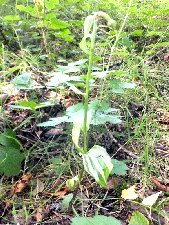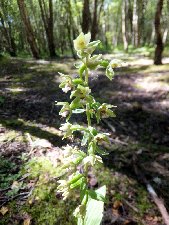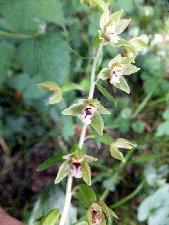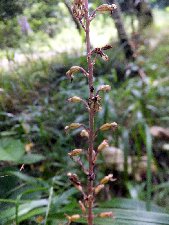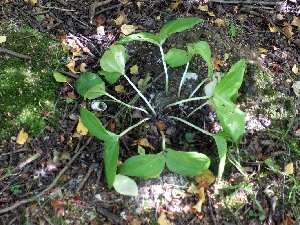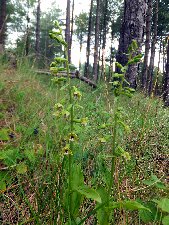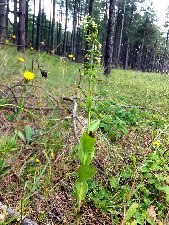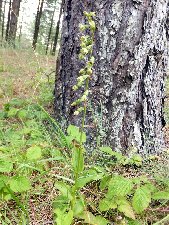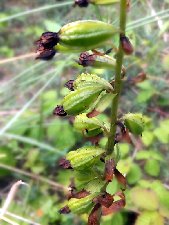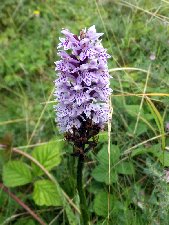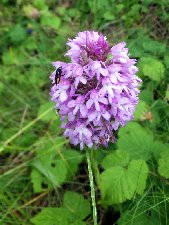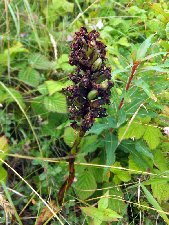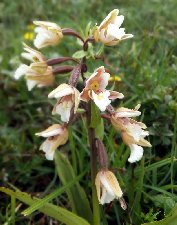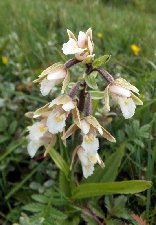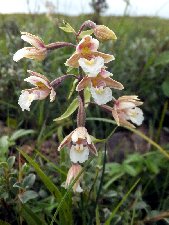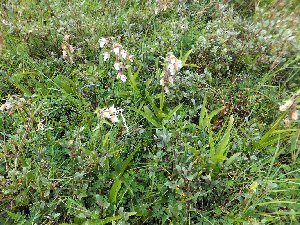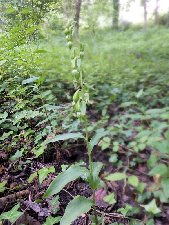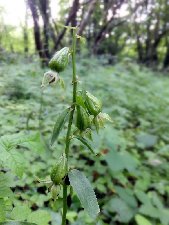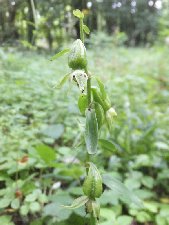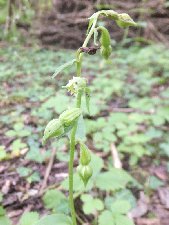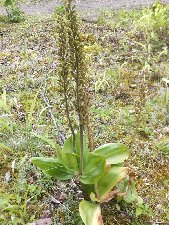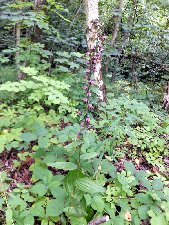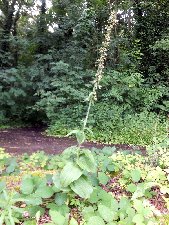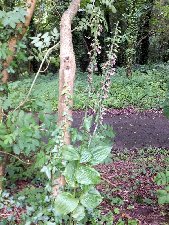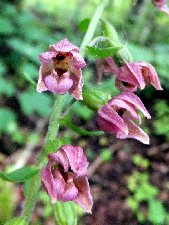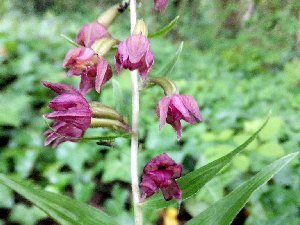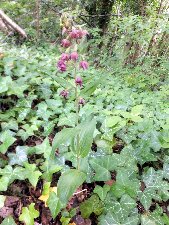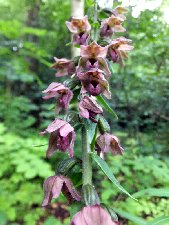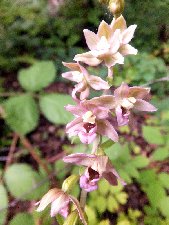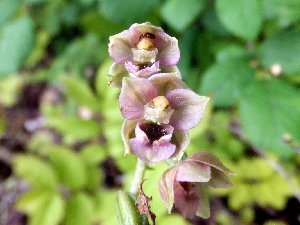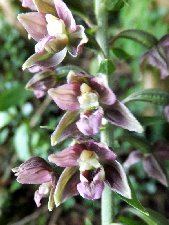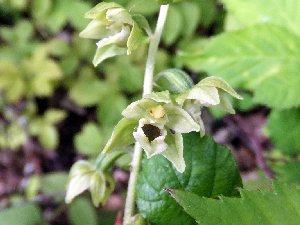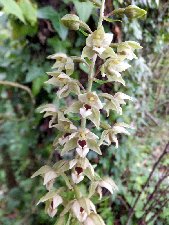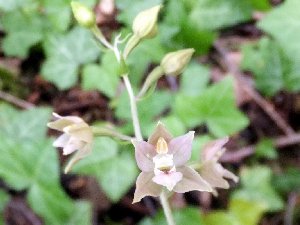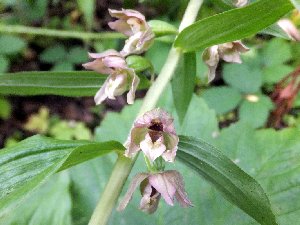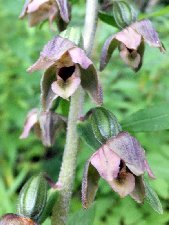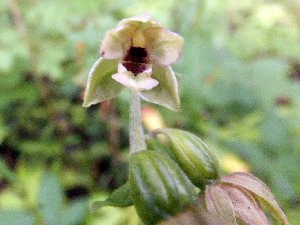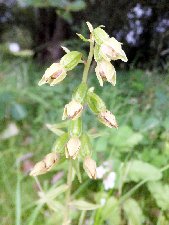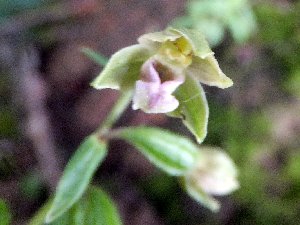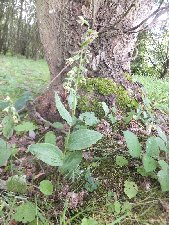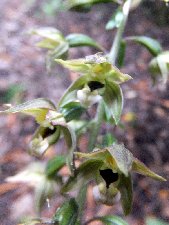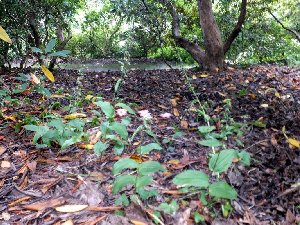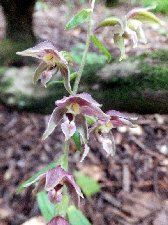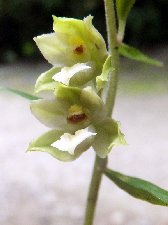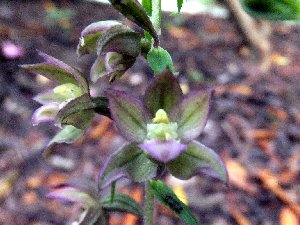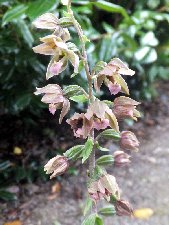|
|
|||||||||||||
|
|
|||||||||||||
 |
|
Leckhampton 15th July 2016 (SO 9459217631) A journey down to Wiltshire provides an opportunity to drop into a few Gloucestershire locations on the way. We are a bit early for the Helleborines, but at least the Achlorophyllous BLH is but a short diversion. As had been reported elsewhere, it has reappeared this year, and is strikingly obvious poking up above the ivy. However, it looks like the flowers buds on the upper part of the stem do not seem to have developed. It will only have a few flowers this year (not that any formed seed in 2015). The day is rather chilly for July (a situation soon to be reversed) and the wind blowing down the road makes photography difficult. The Var. chlorantha next to it looks good, but as it is in tight bud there is no way to tell that this plant is in any way unusual yet. The other Broad-leaved Helleborines are still some way off flowering with the top o the stems bent over; they seemed later at this site than at other sites last year.
Barrow Wake 15th July 2016 (SO 9314915376) Another short diversion off our journey involves Barrow Wake. And it's really only to be able to say that we have seen the Musk Orchids this year. They are perhaps a few days past their peak, both on the slope below the viewpoint, and on the grass behind it, but grow in large numbers.
Others in flower here are the Pyramidal Orchids and the Common Spotted Orchids (just). Workmans Wood 15th July 2016 (SO 8974210854) 2016 is reportedly a bad year for the Red Helleborines, with only one in flower each at this location and that in Hampshire. There were three here, but slugs apparently got there first. Coming here was said to be a waste of time, but we were nearby and it is likely our only chance. A few clues had been posted, like that it could be seen from the lower fence from a couple of positions, but you need a good zoom lens. Unfortunately the lower track past the compound is a couple of feet lower than ground level inside, putting us at a bit of a disadvantage. We must have spent 30 minutes peering into the undergrowth, zooming in on anything vaguely of the right colour, or the right form sticking up above the vegetation - especially where a stick or post marker stood. There was a nice large Broad-leaved Helleborine deep in the depths of the compound just coming into flower, but no C. rubra flowers. However, there was, in the lower right corner, marked with a stick, a non-flowering plant that could only be a Red Helleborine from the leaves and general appearance. So (making up my own rules) I can count this a half sighting.
The lane from Sheepscombe down to the woods is home to Common Spotted and Pyramidal Orchids at the roadside. Pewsey Downs 15th July 2016 (SU 1123763396) The quest for the late-flowering Burnt Orchid starts here on the downland just south-west of Marlborough. We take the path from the car-park and head towards the hill fort summit on the basis that we will cover all altitudes on the climb; often you find orchids growing in a band across a hillside where the conditions are just right for the fussiest of species. It's not until we get to the outer earthbank of the fortifications that we see any orchids in any numbers, and these are the Common Spotted Orchids towards the end of, or past flowering. There is a scattering of Pyramidal Orchids, but they seem solitary specimens. No Burnt Orchids are found, so the highlight of the day are the Frog Orchids. I am familiar with the (mainly) green flowered plants at Eryrys and have seen (many many years ago) more brown tinged flowers at Minera. But here there are some quite hyper-pigmented purplish flowers, and some rather startling near shocking pink plants. I have never seen this shade in any of the books. Also found was a presumed (based on colour and leaves and location) Chalk Fragrant Orchid right at the end of flowering. Some of the other flower stems with developing seed capsules are possibly more of the same.
The walk across to view the Alton Barnes White Horse figure yielded no further orchids. Parsonage Down 16th July 2016 (SU 0345141236) This is said to be the home of the largest colony of Burnt Orchids in Britain. How could we fail. Access is down a by-way apparently open to all traffic, but in reality only to off-road 4x4 vehicles. Are they responsible for creating the humps and ditches on which other cars would get beached? The reserve entrance is nearly a mile from the road, but here the only movement seems to be Marbled White butterflies, and the only sounds are the skylarks. We are at what is said to be the best part of the reserve for orchids, near a prehistoric enclosure. However the grass and other vegetation is all well over a foot long. We make our way down the gentle slope (with some difficulty) but we would need to be directly by any orchids to catch a glimpse of them - they would be buried in all the other growth. Is this all part of reserve management? The temperature today in now hitting 26C in the shade and there is none. We abandon the search reluctantly. The best we can do for sightings is a couple of Pyramidal and Common spotted Orchids on the side of the by-way. Even the prehistoric fort by the main A303, which looks interesting from the map, is off bounds to casual visitors. Coombe Bassett 16th July 2016 This is another site famed for its wild flowers and in particular Burnt Orchids. Indeed much of the top end on the reserve is a mass of wild flowers, but again and alas no orchids at all. We do think about going to the slopes at the far (southern) end, but some cows with their calves are getting very agitated by our presence, bellowing loudly, so it is not a good idea to delve further. Nearby is Clearbury Rings, another Burnt Orchid site. But this is yet another long walk from the road for someone still on crutches, and what has prevented Burnt Orchids appearing here, may well have affected those growing just a few miles away too. At Durrington Walls later that day we find a few scattered Pyramidal Orchids. Ladle Hill 17th July 2016 (SU 4782156878) This location is over the border in Hampshire, and I did get notice before setting out down south that it was home to a number of Burnt Orchids this year. For me it wasn't an easy site. First there was a mile walk down a tree-lined wagon track, and then Ladle Hill to climb. It is a bit steep on the approachable northern side. Again, there are numerous wild flowers, but here and there are also quite a lot of Common Spotted and Pyramidal Orchids, which bodes well. Ladle hill also has a hillfort on top, just like Caburn where we saw the early flowing Burnt Orchids in May. Eventually reaching the fortifications we can see that the orchids are more numerous in the shorter grass, and it's not long before some Burnt Orchids are found. They are actually
Also at the summit we find a few more Frog Orchids in the purple coloured variation (there were probably many more hidden in the vegetation) and the last vestiges of Common Fragrant Orchids in flower.
Alyn Waters Country Park 22nd July 2016 (SJ 3287055112) A third visit here this year, and back on the Llay side. I am expecting only to see the Helleborines. Not a good start though, when the first batch of Green-flowered Helleborines are all missing their flower spikes. This is largely repeated on the next little location that I look at. Now, this could be rabbits, but others have mentioned a lot of slug damage to orchids this year, as a result of a mild winter and wet spring. Whichever the culprits are, they do have a preference for GFH flower spikes. One oddity is a single plant with stripy variegated leaves.
T The Common Spotted Orchids seem to be persisting well, while the Common Twayblades are finishing. The latter do not seem to have set much seed. Only a small proportion have swelling ovaries. This may be a good thing considering how much they appear to be taking over here! On the novelty side one tight group of Twayblades have flopped over into a rosette pattern.
Newborough Forest and Warren 25th July 2016 (SH 3963763809) I should log the woodland and dune slacks at Newborough as separate locations as they are essentially different habitats with some difference in their orchid populations. A job for another day.
A quick trip into the Warren was just to have a look at the Marsh Helleborines. Again, we have not been here at the right time to catch them in flower. Well. they are now, and easy enough to find. What I do notice is that most lack the bright magenta colour on the sepals and petals. At Sweeney Fen last year there were a mixture of examples like these and those in the pink. Not a habitat effect, because they could be found quite close to each other. This is not Var leucantha I suspect I found at Kenfig, more a hypo-pigmented variation. The road north from Newborough passes through the dunes at Aberffraw. We stop, just for 10 minutes to see if there are any Marsh Helleborines around. No, but there are some Pyramidal Orchids on their last legs. This location would be best looked at in June, but so would Ainsdale, another site I have not visited in early summer and easier to get to. Marford Quarry 29th July 2016 (SJ 3547855854) I am here on a quest for a few Dune Helleborines that have come to someone's notice. It's an obvious conclusion that they have spread from Alyn Waters. under 2 miles south west of here as the crow flies. Despite some directions, and knowledge that they were under birch trees, we had no luck despite an extensive search. I also check out a couple of areas with pines that closely resemble the Formby habitat of this species. There's still 2017 though. Here as part of a round trip of the local Helleborine locations. These Broad-leaved Helleborines seem to be putting on a better show this year than 2015. We look around a bit further and find some new, but similar, spots with some nice specimens. What takes my eye today is the number of good sized plants virtually a metre tall. Actually three good plants have survived boys on bikes, while two smaller ones next door have been excommunicated from their rhizomes. There is always a good range of colour here, from quite pale, through to sombre purple shades. One pinkish plant has lateral sepals rather wider than usual; almost circular. Below are some of today's favourites, but best are two that are doing good imitations of Dark-red Helleborines. The flowers are just pure deep red.
In 2014 I though that some Hellborines, closest to the entrance could possibly be self pollinating. Though the flowers had been open a few days the ovaries were quite swollen compared to others on site at the same stage of flowering. Today I see that again. Clustered in one area, variously coloured flowers were involved. Close ups of flowers involved do show a complete if degenerating rostellum, no viscidium present, and little evidence that the pollinia have crumbled in order to self-pollinate. Perhaps they get fertilised within hours of opening. Could there be a wasps nest nearby? Here are some pictures for you to judge for yourselves. We return to the Gwersyllt side to see how the Dune Helleborines are doing, having seen those on the Llay side a few days ago. These too are well and truly at the ending of flowering. I wish we had caught these little beauts at their peak because now their reproductive structures are disintegrating and they all look a bit sad. All are under the trees and in shade, so photos are not the best. Bodnant 30th July 2016 (SH 7989372186) Three years ago, at the end of August, at Bodnant Gardens, I chanced upon some Helleborines with fruiting bodies growing under the cover of Rhodedendrons. Today is the chance to show that they are Broad-leaved Helleborines. They grow next to a bed labeled area 27, below a giant sequoia, along the top path above the dell. Yes, they are that species, and there are about 20 plants in this spot in flower, with others sporadically in other beds along that path. You can clearly see a viscidium on some of these flowers.
|
|
|
||||||||||||||||||||
